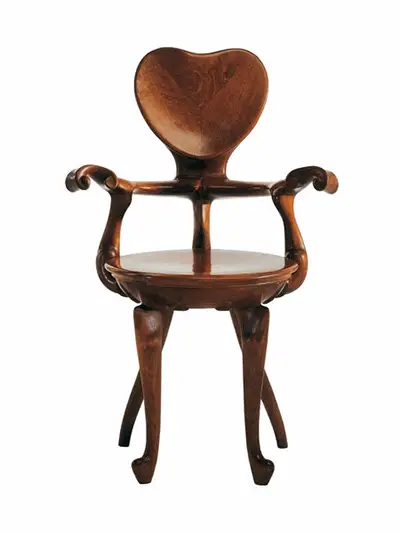 Buy Art Prints Now
Buy Art Prints Nowfrom Amazon
* As an Amazon Associate, and partner with Google Adsense and Ezoic, I earn from qualifying purchases.
Most visitors to the Catalan city of Barcelona will be well aware of Antoni Gaudi's buildings and architectural design but fewer will know about his work in other disciplines such as furniture, interior design and drawing.
The artist's obsessive nature meant he wanted to design everything within his projects, both the exterior facades as well as the features within each room. Gaudi would adapt the contents of his buildings to match the overall theme of the project and would produce both Baroque and also Catalan Modernist architecture. He would create furniture with specific intentions, a particular location in which it was to be placed once complete. This would challenge the artist as he would need to master different styles of furniture design on top of his existing commitments to other disciplines though his extraordinary passion and curiosity would help to drive him forwards against a large backlog of work.
Thankfully, just as Gaudi's buildings have been wonderfully preserved, so have the contents within them. A variety of his building designs were added to the UNESCO list of culturally significant works of art and this also helped to boost efforts to protect both his original work plus also the legacy and reputation that he build up during his own lifetime. With most of these buildings serving as popular tourist destinations, there continues to be considerable exposure to his most significant pieces of furniture which are generally still in the same position that they were originally designed to be. He would invariably deliver furniture in line with the individual building construction deadlines before moving on to the next task but there are some examples of designs which were not linked to any specific building.
Cadas and Bardes were the two main carpenters tasked with bringing Gaudi's furniture designs into reality. They produced many items out of oak wood and would always attempt to limit the number of different materials that they used in each piece. The two set up Casas i Bardés which also catered for ceiling and floor design as well. Several other notable tradesmen of the time have also been linked to Gaudi's career, but there has been little evidence to conclusively connect their careers together. Many original Casas i Bardés products are still in existence within Gaudi's buildings, though some have since been moved elsewhere to private or public collections. For example, there is an upright chair from 1900-1901 now located at the Museu Nacional d'Art de Catalunya as well as Sillón Calvet to be found in the collection of Inter-American Development Bank.
Gaudi entered the world of furniture design early in his career, very soon after graduating from the School of Architecture. At this stage in his life he was still excited by his move to the city of Barcelona and all the influences that this location brought. He was also able to study a large breadth of artistic styles from educational libraries as well as the various collections on display around the city. Young students will typically explore all manner of ideas and techniques at this stage of their development, before later starting to form something of a signature style and Gaudi was very much the same in this regard. The artist felt an organic connection between the contents of his buildings and their external facades, with a project being an overall series of artworks that together should fit stylistically. As his architectural designs would take in different styles across his career, so would his furniture designs need to do, be it Art Nouveau, Catalan Modernism, Gothic or Baroque.
The styles found in his architecture would continue into his other creations, such as with a use of curves rather than straight lines which promoted his use of a natural theme across his career. He once claimed that, ultimately, his designs were merely reproductions of nature, inspired by his religious convictions. You will, for this reason, not find many straight lines within his furniture either. The carpenters would make use of oak most frequently, due to its strength and durability as well as the ease with which it could be manipulated. The curved features almost link the designs to the original source, resembling flowing branches that wrap around the main section of each item. Others have suggested that the curves resemble insects and animals, and an argument can be made for both opinions.
There are a number of furniture retailers that have brought his designs to life through reproductions of his original work. These are available online though command high valuations. In order to successfully replicate the originals, a huge attention to detail was required as well as some modern carpenters having to research and practice some traditional techniques. It has been a true joy for many but also has taken considerable time. Thus there are not that many good reproductions of his work available, but enough to ensure that his career continues into the future. There is enough documentation remaining that examines his techniques of production, thus enabling modern carpenters to fairly accurately replicate his designs. They will never quite match his own inventions that were put together in the workshop of Cadas and Bardes but a close second will suffice for those who have a particular interest in Gaudi's contributions to this artistic discipline. Additionally, others will choose art print reproductions, generally being photographs of his original sculptures, drawings and building designs.




